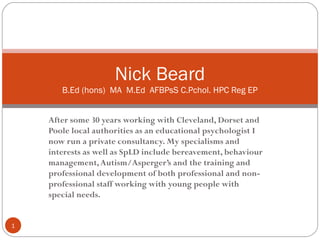
Nick Beard - Appropriate Evidence for DSA July 2012
- 1. Nick Beard B.Ed (hons) MA M.Ed AFBPsS C.Pchol. HPC Reg EP After some 30 years working with Cleveland, Dorset and Poole local authorities as an educational psychologist I now run a private consultancy. My specialisms and interests as well as SpLD include bereavement, behaviour management, Autism/Asperger’s and the training and professional development of both professional and non- professional staff working with young people with special needs. 1
- 2. Advance Organiser The difference demands for Eps working in school, FE and HE contexts Definitions of dyslexia and why they matter The content of the psychological report Reasons for failure to identify Other SpLDs 2
- 3. The difference for Eps between working for schools/LAs and HE HE School/LA Diagnosis of “condition” Exploration of strengths and weaknesses Producing an acceptable Producing realistic and useful “label” recommendations Opening the gate to Implying who should pay for additional help additional input 3
- 4. Definitions of dyslexia The British Psychological Society, 1999, define Dyslexia as “evident when accurate and fluent word reading and/or spelling develops very incompletely or with great difficulty, despite appropriate learning opportunities – that is learning opportunities which are effective for the great majority of children”. The Rose Report by Sir Jim Rose (June 2009) identified the following working definition of dyslexia: Dyslexia is a learning difficulty that primarily affects the skills involved in accurate and fluent word reading and spelling. Characteristic features of dyslexia are difficulties in phonological awareness, verbal memory and verbal processing speed. Dyslexia occurs across a range of intellectual abilities. It is best thought of as a continuum, not a distinct category, and there are no clear cut-off points. Co-occurring difficulties may be seen in aspects of language, motor coordination, mental calculation, concentration and personal organisation, but these are not, by themselves, markers of dyslexia. 4
- 5. Definitions of dyslexia A commonly accepted definition of dyslexia in further/higher education (SpLD Working Group – 2005 – DfES Guidelines, page 5) describes “A combination of abilities and difficulties where the difficulties affect the learning process in aspects of literacy and sometimes numeracy. Marked and persistent weaknesses may be identified in working memory, speed of processing, sequencing skills, auditory and/or visual perception, spoken language and motor skills”. 5
- 6. Some implications A student might be dyslexic using one of the above definitions, but not using another. The EP therefore needs to produce evidence as to why they regard the student as being dyslexic. This evidence needs to be replicable – ie another EP using the same methodology with the same student should get more or less the same results. Higher education still tends to favour a discrepancy model, which links in well with the Working Group model – given this person’s overall scores, how probable or improbable are their discrepant scores? 6
- 7. The psychological report There will normally be an indication of overall ability, obtained from a “closed” normative test, together with comments about any unusual variations in the subtest scores. This will typically include scores for verbal and non-verbal ability together with results and discussion on working memory, and processing speed. There will be an indication of scores on standardised literacy tests, looking at different sorts of reading and writing together with comments on areas of strength and weaknesses and whether or not these are unusual. There should be an indication as to the extent to which the literacy scores would have been predicted from the ability scores . There will often be a further set of tests to follow up any hypotheses or to produce further evidence. 7
- 8. Example of a significant discrepancy Subtest Predicted Actual Score Difference Level of Frequency Score statistical of difference significance in normative sample Word 99 110 +11 n/a n/a Reading Reading 99 102 +3 n/a n/a Comp Spelling 99 99 0 n/s n/a PS Decoding 99 114 +15 n/s n/a Written 99 70 29 .01 1% Expression Comp 99 110 +11 n/a n/a Reading Comp WR L 99 84 15 .01 10% 8
- 9. The Psychological report -2 There will normally be an indication that any other issues which might be affecting the situation has been checked and eliminated or allowed for – sensory difficulties, missing or problematic education, difficult family circumstances and so on. It’s often helpful to know if other members of the family have similar difficulties. 9
- 10. Keeping it “legal” The Working Group reports lays down various other requirements which EP (and other) reports should adhere to. Reports should carry a note indicating that they have been written “in accordance with the SpLD Working Group Guidelines for assessing SpLDs in Higher Education” 10
- 11. How do they get this far without identified? Deficit difficulties: Institutes with no systems or other priorities No or minimal independent study skills input Reluctance by student or institute to acknowledge problem Subtle difficulties that don’t show at more basic levels of work Positive difficulties: Being bright and working hard overcomes difficulty at FE level Huge amounts of input/support from others Also: Course has literacy demands but doesn’t assess for them on entry 11
- 12. 12
- 13. Other SpLDs If they are in DSM IV they are theoretically medical diagnosis: this is true of ADHD, ADD, Dyspraxia and so on. Much more difficult to test for: normative tests aren't usually very useful. Therefore DSM criteria allied to checklists, self reports and (given agreement) reports from others along with observation during the assessment are the basis for “diagnosis.” In HE any people with these sorts of difficulties tend to get swept up into the “dyslexia with additional difficulties” categories and may therefore need referring on. 13